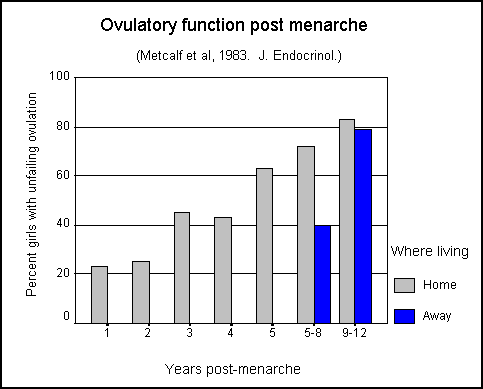
Development of adolescent fertility post-menarche
Follow-up
to class discussion 10/15
Metcalf
et al (1983) examined the menstrual cycles of 209 females living with
their parents and 59 living away from their parents using urine weekly urine
analysis over a three month period to establish ovulation by the presence of
hormones in the urinary output. They
found that most young women established a regular pattern of ovulatory cycles
after 5 years. The proportion of
young women living away form home who had anovulatory cycles was elevated within
5-8 years post menarche, but was not significantly different from the young
women living with their parents by 9-12 years after their menstrual cycles
began.

Why
does it take time?
Although
a girl’s normal
pubertal development is often considered complete when she experiences her first
menstrual period, “sexual maturity is not attained until the onset of regular
ovulatory cycles, which may take a number of months to years to accomplish. This
maturation process is orchestrated by a neuroendocrine cascade and modified by
autocrine and paracrine events in the ovary. The control of these complex
relationships takes time and could not be expected to be fully functional with
menarche. During the first menstrual months, the hypothalamic-pituitary-ovarian
axis is immature, resulting in the secretion of only estrogens from the
developing follicles; positive feedback to trigger ovulation develops later.
Consequently, estrogen secretion is variable and unopposed by progesterone,
which would normally be produced in ovulatory cycles. Estrogen-only primed
endometrium often leads to irregular menstrual cycles with variable flow.
Surprisingly, most adolescents do well and have few complaints in spite of these
anovulatory cycles” (Spence, 1997, p. 173).
Metcalf,
M.G., Skidmore, D.S., Lowry, G.F. & Mackenzie, JA. (1983). Incidence of
ovulation in the years after the menarche.
Journal of Endocrinology, 97, 213-219.
Spence, J.E. (1997).
Anovulation and monophasic cycles. Annals of the
New York Academy of Science, 816, 173-176.